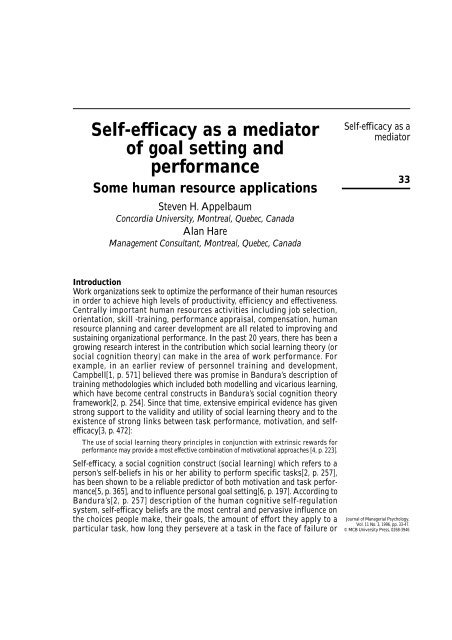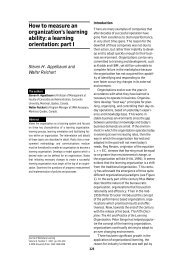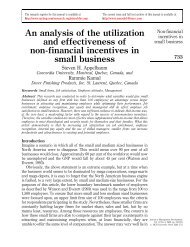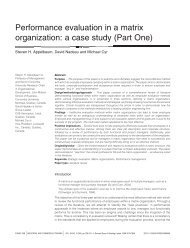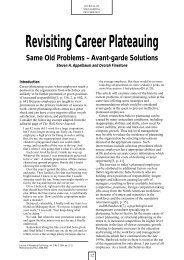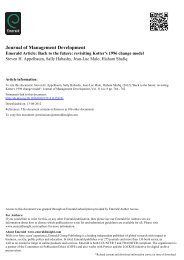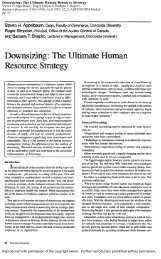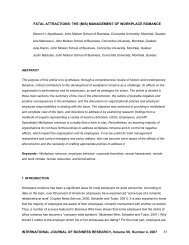Self-efficacy as a mediator of goal setting and performance
Self-efficacy as a mediator of goal setting and performance
Self-efficacy as a mediator of goal setting and performance
Create successful ePaper yourself
Turn your PDF publications into a flip-book with our unique Google optimized e-Paper software.
<strong>Self</strong>-<strong>efficacy</strong> <strong>as</strong> a <strong>mediator</strong><br />
<strong>of</strong> <strong>goal</strong> <strong>setting</strong> <strong>and</strong><br />
<strong>performance</strong><br />
Some human resource applications<br />
Steven H. Appelbaum<br />
Concordia University, Montreal, Quebec, Canada<br />
Alan Hare<br />
Management Consultant, Montreal, Quebec, Canada<br />
<strong>Self</strong>-<strong>efficacy</strong> <strong>as</strong> a<br />
<strong>mediator</strong><br />
33<br />
Introduction<br />
Work organizations seek to optimize the <strong>performance</strong> <strong>of</strong> their human resources<br />
in order to achieve high levels <strong>of</strong> productivity, efficiency <strong>and</strong> effectiveness.<br />
Centrally important human resources activities including job selection,<br />
orientation, skill -training, <strong>performance</strong> appraisal, compensation, human<br />
resource planning <strong>and</strong> career development are all related to improving <strong>and</strong><br />
sustaining organizational <strong>performance</strong>. In the p<strong>as</strong>t 20 years, there h<strong>as</strong> been a<br />
growing research interest in the contribution which social learning theory (or<br />
social cognition theory) can make in the area <strong>of</strong> work <strong>performance</strong>. For<br />
example, in an earlier review <strong>of</strong> personnel training <strong>and</strong> development,<br />
Campbell[1, p. 571] believed there w<strong>as</strong> promise in B<strong>and</strong>ura’s description <strong>of</strong><br />
training methodologies which included both modelling <strong>and</strong> vicarious learning,<br />
which have become central constructs in B<strong>and</strong>ura’s social cognition theory<br />
framework[2, p. 254]. Since that time, extensive empirical evidence h<strong>as</strong> given<br />
strong support to the validity <strong>and</strong> utility <strong>of</strong> social learning theory <strong>and</strong> to the<br />
existence <strong>of</strong> strong links between t<strong>as</strong>k <strong>performance</strong>, motivation, <strong>and</strong> self<strong>efficacy</strong>[3,<br />
p. 472]:<br />
The use <strong>of</strong> social learning theory principles in conjunction with extrinsic rewards for<br />
<strong>performance</strong> may provide a most effective combination <strong>of</strong> motivational approaches [4, p. 223].<br />
<strong>Self</strong>-<strong>efficacy</strong>, a social cognition construct (social learning) which refers to a<br />
person’s self-beliefs in his or her ability to perform specific t<strong>as</strong>ks[2, p. 257],<br />
h<strong>as</strong> been shown to be a reliable predictor <strong>of</strong> both motivation <strong>and</strong> t<strong>as</strong>k <strong>performance</strong>[5,<br />
p. 365], <strong>and</strong> to influence personal <strong>goal</strong> <strong>setting</strong>[6, p. 197]. According to<br />
B<strong>and</strong>ura’s[2, p. 257] description <strong>of</strong> the human cognitive self-regulation<br />
system, self-<strong>efficacy</strong> beliefs are the most central <strong>and</strong> perv<strong>as</strong>ive influence on<br />
the choices people make, their <strong>goal</strong>s, the amount <strong>of</strong> effort they apply to a<br />
particular t<strong>as</strong>k, how long they persevere at a t<strong>as</strong>k in the face <strong>of</strong> failure or<br />
Journal <strong>of</strong> Managerial Psychology,<br />
Vol. 11 No. 3, 1996, pp. 33-47.<br />
© MCB University Press, 0268-3946
Journal <strong>of</strong><br />
Managerial<br />
Psychology<br />
11,3<br />
34<br />
difficulty, the amount <strong>of</strong> stress they experience <strong>and</strong> the degree to which they<br />
are susceptible to depression.<br />
Human resource management application<br />
The changeable <strong>as</strong>pect <strong>of</strong> self-<strong>efficacy</strong> beliefs[7, p. 198] should be <strong>of</strong> great<br />
interest to the human resource management pr<strong>of</strong>essional: the potential to<br />
influence directly t<strong>as</strong>k <strong>performance</strong> through incre<strong>as</strong>ing self-<strong>efficacy</strong> beliefs. A<br />
number <strong>of</strong> studies have demonstrated significantly higher t<strong>as</strong>k <strong>performance</strong><br />
following “manipulations” designed to enhance self-<strong>efficacy</strong>, including<br />
managerial problem-solving training[8, p. 803], general analytic skill<br />
development[9, p. 94], job attendance[10, p. 415], complex decision-making<br />
t<strong>as</strong>ks[6, p. 197], <strong>and</strong> management retraining[11, p. 198]. <strong>Self</strong>-<strong>efficacy</strong> beliefs<br />
have also been shown to be correlated with <strong>and</strong> predictive <strong>of</strong> burnout[12,<br />
p. 745], stress[5, p. 371], supervisor ratings <strong>of</strong> <strong>performance</strong>[13, p. 80], <strong>and</strong> role<br />
adjustments <strong>of</strong> newcomers to organizations[14, p. 274]. These findings point<br />
to the previously identified centrality <strong>of</strong> self-<strong>efficacy</strong> beliefs with respect to<br />
<strong>performance</strong> <strong>and</strong> key human resource implications. The specific applications<br />
arising from the theoretical <strong>and</strong> empirical frameworks <strong>as</strong>sociated with self<strong>efficacy</strong><br />
<strong>and</strong> which have utility in human resource management applications<br />
are a major focus <strong>of</strong> this research.<br />
The field <strong>of</strong> human resources management h<strong>as</strong> (apparently) been slow to<br />
address <strong>and</strong> technically incorporate the applied <strong>as</strong>pects <strong>of</strong> social cognition<br />
theory <strong>and</strong> self-<strong>efficacy</strong>, despite the impressive empirical support it h<strong>as</strong><br />
received. Gist[3, p. 472], in an article addressing the implications <strong>of</strong> self-<strong>efficacy</strong><br />
for organizational behaviour <strong>and</strong> human resources management, further points<br />
out that there is little evidence that much attention h<strong>as</strong> been paid to<br />
organizational applications. Considering the empirical evidence, however, it<br />
would seem that the application <strong>of</strong> social cognition theory is a future trend in<br />
these are<strong>as</strong> <strong>and</strong>, by extension, an important area to be considered by human<br />
resources management.<br />
In recent years, management practices in the area <strong>of</strong> work motivation <strong>and</strong><br />
<strong>performance</strong> have typically reflected <strong>goal</strong>-<strong>setting</strong> theory <strong>and</strong> the notion <strong>of</strong><br />
instrumentality <strong>of</strong> rewards. Goal-<strong>setting</strong> theory h<strong>as</strong> shown that the <strong>setting</strong> <strong>of</strong><br />
re<strong>as</strong>onably challenging <strong>goal</strong>s leads to incre<strong>as</strong>ed <strong>performance</strong>. Similarly, the<br />
matching <strong>of</strong> incentives <strong>and</strong> rewards to individual preferences h<strong>as</strong> also been<br />
shown to enhance motivation <strong>and</strong> <strong>performance</strong>[15, p. 642]. Performance<br />
appraisal systems <strong>and</strong> compensation schemes have therefore embraced some<br />
<strong>as</strong>pects <strong>of</strong> current motivation theory, yet have overlooked the me<strong>as</strong>urement <strong>and</strong><br />
modification <strong>of</strong> subjective evaluations <strong>of</strong> t<strong>as</strong>k competence (self-<strong>efficacy</strong>) <strong>and</strong><br />
outcome expectations.<br />
The objective <strong>of</strong> this article is to examine the theoretical framework <strong>and</strong><br />
empirical support for self-<strong>efficacy</strong> <strong>as</strong> a <strong>mediator</strong> <strong>of</strong> motivation, <strong>goal</strong> <strong>setting</strong> <strong>and</strong><br />
<strong>performance</strong>, <strong>and</strong> to examine the specific (applied) implications <strong>of</strong> self-<strong>efficacy</strong><br />
beliefs for the human resources management field. This undertaking will
conclude with the possibilities for an incre<strong>as</strong>ingly important role for self<strong>efficacy</strong><br />
theory with respect to current <strong>and</strong> future trends..<br />
<strong>Self</strong>-<strong>efficacy</strong>: a theoretical framework<br />
This research will begin with self-<strong>efficacy</strong> in terms <strong>of</strong> how it is defined,<br />
characterized <strong>and</strong> me<strong>as</strong>ured. Sources <strong>of</strong> beliefs will be examined <strong>as</strong> well <strong>as</strong> the<br />
dynamic determinants <strong>of</strong> these beliefs. Individual differences will be explored<br />
<strong>and</strong> followed by an analysis <strong>of</strong> <strong>goal</strong> <strong>setting</strong> <strong>and</strong> its impact on <strong>performance</strong>.<br />
Social cognition theory, b<strong>as</strong>ed on a model <strong>of</strong> triadic reciprocal causation,<br />
emph<strong>as</strong>izes the interplay between behaviour, environmental influences <strong>and</strong><br />
personal subjective factors including cognition to explain human psychosocial<br />
functioning[5, p. 361]. The role <strong>of</strong> cognition – that <strong>as</strong>pect <strong>of</strong> our mental life<br />
involving conscious thought processes (including such key elements <strong>as</strong><br />
re<strong>as</strong>oning, problem solving, decision making <strong>and</strong> evaluative judgements) – is<br />
given special emph<strong>as</strong>is within this conceptual framework. In a description <strong>of</strong><br />
social cognitive theory, B<strong>and</strong>ura[2, p. 248] argues for the existence <strong>of</strong> central<br />
(cognitive) self-regulation processes which mediate experience <strong>and</strong> behaviour.<br />
B<strong>and</strong>ura suggests that much <strong>of</strong> human behaviour is regulated by forethought,<br />
allowing people to behave in a proactive f<strong>as</strong>hion <strong>and</strong> engage in <strong>goal</strong> <strong>setting</strong>,<br />
thus channelling motivation. He considers this capacity <strong>of</strong> self-directedness to<br />
be mediated by self-reflective <strong>and</strong> self-reactive capabilities which are in a state<br />
<strong>of</strong> constant interplay with environmental influences. It is from such selfreflective<br />
<strong>and</strong> self-reactive capabilities that self-<strong>efficacy</strong> beliefs are thought to<br />
emerge.<br />
<strong>Self</strong>-<strong>efficacy</strong> <strong>as</strong> a<br />
<strong>mediator</strong><br />
35<br />
<strong>Self</strong>-<strong>efficacy</strong>: definition, characteristics <strong>and</strong> me<strong>as</strong>urement<br />
The construct <strong>of</strong> self-<strong>efficacy</strong> refers to “people’s beliefs about their capability to<br />
exercise control over their own level <strong>of</strong> functioning <strong>and</strong> over events that affect<br />
their lives”[2, p. 257]. <strong>Self</strong>-<strong>efficacy</strong> beliefs are considered to be the outcome <strong>of</strong> a<br />
process <strong>of</strong> weighing, integrating, <strong>and</strong> evaluating information about one’s<br />
capabilities, <strong>and</strong> which, in turn, regulate the choices people make <strong>and</strong> the amount<br />
<strong>of</strong> effort they apply to a given t<strong>as</strong>k[3, p. 472]. <strong>Self</strong>-<strong>efficacy</strong> judgements vary over<br />
time on the b<strong>as</strong>is <strong>of</strong> new information <strong>and</strong> experience[7, p. 184]. Thus, self-<strong>efficacy</strong><br />
is a dynamic concept. <strong>Self</strong>-<strong>efficacy</strong> beliefs are also <strong>as</strong>sociated primarily with<br />
specific t<strong>as</strong>k conditions, even though, <strong>as</strong> will be noted later, there is considered to<br />
be a degree <strong>of</strong> generalization <strong>of</strong> self-<strong>efficacy</strong> beliefs across related t<strong>as</strong>k situations<br />
<strong>and</strong> <strong>of</strong> a person’s general sense <strong>of</strong> efficaciousness[2, p. 258].<br />
Three dimensions <strong>of</strong> self-<strong>efficacy</strong> are identified: magnitude, strength <strong>and</strong><br />
generality[3, p. 472]. Magnitude refers to the level <strong>of</strong> t<strong>as</strong>k difficulty a person<br />
believes he or she can attain; strength refers to the degree <strong>of</strong> conviction that a<br />
given level <strong>of</strong> t<strong>as</strong>k <strong>performance</strong> is attainable; <strong>and</strong> generality refers to the extent<br />
to which a given self-<strong>efficacy</strong> judgement applies across different situations.<br />
Magnitude <strong>and</strong> strength <strong>of</strong> self-<strong>efficacy</strong> judgements are the b<strong>as</strong>is <strong>of</strong> most<br />
me<strong>as</strong>urements <strong>of</strong> self-<strong>efficacy</strong>. Typically, a person may be <strong>as</strong>ked to indicate with<br />
a “yes” or “no” answer whether they feel that they can attain various specified
Journal <strong>of</strong><br />
Managerial<br />
Psychology<br />
11,3<br />
36<br />
levels <strong>of</strong> t<strong>as</strong>k <strong>performance</strong> <strong>and</strong>, second, indicate how confident they are to reach<br />
each attainable level <strong>of</strong> <strong>performance</strong> <strong>as</strong> an example, by <strong>as</strong>signing a number<br />
from 1 to 100. Magnitude is then determined by aggregating total “yes”<br />
responses, <strong>and</strong> strength determined by aggregating confidence responses[8,<br />
p. 797]. It should be noted that generality is not normally me<strong>as</strong>ured.<br />
Sources <strong>of</strong> self-<strong>efficacy</strong> beliefs<br />
Four major sources <strong>of</strong> self-<strong>efficacy</strong> beliefs have been identified[5, p. 364];<br />
enactive m<strong>as</strong>tery experiences, modelling, social persu<strong>as</strong>ion <strong>and</strong> psychological<br />
states. Each <strong>of</strong> these sources h<strong>as</strong> particular significance when considering<br />
applications in organizational work environments. Enactive m<strong>as</strong>tery<br />
experiences refer to the strengthening <strong>of</strong> self-<strong>efficacy</strong> beliefs <strong>as</strong> a result <strong>of</strong> t<strong>as</strong>k<br />
accomplishment. Within the triadic reciprocal causation model, this source is<br />
<strong>as</strong>sociated with the influence <strong>of</strong> behaviour on self-<strong>efficacy</strong> beliefs. It is<br />
suggested that a resilient sense <strong>of</strong> <strong>efficacy</strong> is developed when a person is able to<br />
overcome challenging obstacles through perseverance, an experience which<br />
provides <strong>as</strong>surance <strong>of</strong> one’s capabilities <strong>and</strong> which allows a person to endure<br />
setbacks <strong>and</strong> failures without loss <strong>of</strong> confidence. E<strong>as</strong>y successes result in an<br />
expectation <strong>of</strong> quick results, leading to rapid discouragement in the face <strong>of</strong><br />
failure. As will be seen, the strengthening or weakening <strong>of</strong> self-<strong>efficacy</strong> beliefs<br />
through t<strong>as</strong>k experience h<strong>as</strong> major implications for work experiences,<br />
particularly with respect to the success or lack <strong>of</strong> success experienced by a<br />
person in his/her position <strong>and</strong> the t<strong>as</strong>k conditions which can be adjusted to<br />
facilitate that success.<br />
Vicarious experience or modelling[3, p. 473] is a second important source <strong>of</strong><br />
self-<strong>efficacy</strong> beliefs <strong>and</strong> is primarily <strong>as</strong>sociated with environmental influences.<br />
Modelling refers to the observation <strong>of</strong> another person – the model – performing<br />
the t<strong>as</strong>k in question. The model, through successful efforts, conveys to the<br />
observing person possible t<strong>as</strong>k strategies, a b<strong>as</strong>is for (social) comparison <strong>and</strong><br />
judgement <strong>of</strong> their own abilities, <strong>and</strong> encouragement to believe that through<br />
effort, despite setbacks, the t<strong>as</strong>k can be successfully accomplished. The effects<br />
<strong>of</strong> modelling are related to the similarity between the model <strong>and</strong> the observer<br />
(for example age <strong>and</strong> capability). The desire to imitate models can be very<br />
powerful. Modelling first manifests itself in childhood, when children imitate<br />
adults <strong>and</strong> other siblings. In organizations, a desire to imitate superior<br />
performers or supervisors may be strong in some individuals. Certainly, the<br />
taking <strong>of</strong> roles <strong>and</strong> the imitation <strong>of</strong> previously witnessed behaviour illustrate<br />
the subtle influences <strong>of</strong> social learning[4, p. 222]. The impact in organizational<br />
<strong>setting</strong>s <strong>of</strong> this source <strong>of</strong> self-<strong>efficacy</strong> h<strong>as</strong> implications both in everyday<br />
uncontrolled situations where one person observes another doing the same t<strong>as</strong>k<br />
<strong>as</strong> part <strong>of</strong> the normal flow <strong>of</strong> work, <strong>and</strong> with respect to training activities where<br />
modelling can be applied systematically <strong>as</strong> a learning methodology.<br />
Verbal or social persu<strong>as</strong>ion (an environmental influence), although less<br />
effective than enactive m<strong>as</strong>tery or modelling, is considered to be an important<br />
source <strong>of</strong> self-<strong>efficacy</strong> beliefs. This objective <strong>of</strong> verbal persu<strong>as</strong>ion is to convey to
the person faced with the t<strong>as</strong>k <strong>of</strong> utilizing their ability to succeed, is to not create<br />
unrealistically high expectations which may well affect the person negatively if<br />
they fail at the t<strong>as</strong>k. Social persu<strong>as</strong>ion is used on a widespread, ad hoc b<strong>as</strong>is <strong>as</strong><br />
a normal form <strong>of</strong> encouragement; however, the strategic use <strong>of</strong> this technique<br />
within a skill development <strong>setting</strong> can result in greater t<strong>as</strong>k-directed effort<br />
which is particularly useful in the early stages <strong>of</strong> skill development.<br />
A person’s perception <strong>of</strong> his/her physiological state (subjective personal<br />
influences), will influence his/her judgement <strong>of</strong> self-<strong>efficacy</strong>. If they feel fearful,<br />
anxious, or tense, they may judge themselves less capable to accomplish a given<br />
t<strong>as</strong>k. Fatigue or pain will negatively affect self-<strong>efficacy</strong> judgements related to<br />
t<strong>as</strong>ks involving physical exertion[5, p. 365]. Efforts to improve either<br />
psychological or physical states, through efforts to reduce stress or improve<br />
physical condition, can be considered <strong>as</strong> ways to improve self-<strong>efficacy</strong><br />
judgements.<br />
Through the ongoing influence <strong>of</strong> these information sources, self-<strong>efficacy</strong><br />
beliefs are gradually acquired <strong>and</strong> consolidated through experience. As w<strong>as</strong><br />
briefly noted, each <strong>of</strong> these four sources h<strong>as</strong> particular implications in the area<br />
<strong>of</strong> work organizations <strong>and</strong> human resources management. However, there are a<br />
variety <strong>of</strong> other factors which influence the development <strong>of</strong> self-<strong>efficacy</strong> beliefs<br />
<strong>and</strong> will be examined.<br />
<strong>Self</strong>-<strong>efficacy</strong> <strong>as</strong> a<br />
<strong>mediator</strong><br />
37<br />
Dynamic determinants <strong>of</strong> self-<strong>efficacy</strong> beliefs: two experiments<br />
Some <strong>of</strong> the major factors which influence development <strong>of</strong> self-<strong>efficacy</strong> include<br />
beliefs in the nature <strong>of</strong> ability[7, p. 190], information or <strong>as</strong>sumptions which link<br />
successful <strong>performance</strong> to internal or external factors[2, p. 357], estimations <strong>of</strong><br />
controllability, feedback received regarding previous efforts[16, p. 65],<br />
attributions made regarding the outcome <strong>of</strong> previous experiences[17, p. 293],<br />
specific t<strong>as</strong>k requirements <strong>and</strong> the degree <strong>of</strong> interdependence on the efforts <strong>of</strong><br />
others.<br />
In a key experiment which addressed self-<strong>efficacy</strong> <strong>and</strong> <strong>goal</strong> -<strong>setting</strong> with<br />
respect to complex decision-making t<strong>as</strong>ks in an organizational context, Wood<br />
<strong>and</strong> B<strong>and</strong>ura[5, p. 371] demonstrated the effects <strong>of</strong> a number <strong>of</strong> these dynamic<br />
determinants on self-<strong>efficacy</strong>. Using a computer-simulated organizational<br />
environment, business school students engaged in managerial decision-making<br />
t<strong>as</strong>ks with the <strong>goal</strong> <strong>of</strong> attaining higher organizational <strong>performance</strong>. The<br />
participants were provided with descriptions <strong>of</strong> each productive activity in the<br />
organization, together with information regarding each employee’s characteristics,<br />
including skills, experience, motivation, work preference <strong>and</strong> work<br />
quality st<strong>and</strong>ards. Each participant engaged in a series <strong>of</strong> 16 trials, allowing<br />
changes in <strong>performance</strong> to be me<strong>as</strong>ured with incre<strong>as</strong>ing experience. In one<br />
control group, students were led to believe (manipulated) that (cognitive) ability<br />
<strong>as</strong> a manager w<strong>as</strong> either an acquirable skill or a fixed inherent capacity. A<br />
further description <strong>of</strong> this structured experiment w<strong>as</strong> supplied by Wood <strong>and</strong><br />
B<strong>and</strong>ura:
Journal <strong>of</strong><br />
Managerial<br />
Psychology<br />
11,3<br />
38<br />
Managers who were led to construe their decision-making ability <strong>as</strong> reflective <strong>of</strong> their inherent<br />
cognitive aptitude were beset by incre<strong>as</strong>ing doubts about their managerial <strong>efficacy</strong> <strong>as</strong> they<br />
encountered problems. They became more <strong>and</strong> more erratic in their decisional activities, they<br />
lowered their organizational <strong>as</strong>pirations, <strong>and</strong> they achieved progressively less with the<br />
organization they were managing. In marked contr<strong>as</strong>t, managers with an induced conception <strong>of</strong><br />
ability <strong>as</strong> an acquirable skill fostered a highly resilient sense <strong>of</strong> personal <strong>efficacy</strong>. Even though<br />
they were <strong>as</strong>signed taxing <strong>goal</strong>s that were difficult to fulfil, these managers remained steadf<strong>as</strong>t<br />
in their perceived managerial self-<strong>efficacy</strong>, they continued to set for themselves challenging<br />
organizational <strong>goal</strong>s, <strong>and</strong> they used analytical strategies in ways which aided the discovery <strong>of</strong><br />
optimal managerial decision rules. Such a self-efficacious orientation, which is well-suited to<br />
h<strong>and</strong>ling adversity, paid <strong>of</strong>f in uniformly high organization attainments[5, p. 373].<br />
A second manipulation encouraged participants to believe that organizations<br />
are either relatively controllable or uncontrollable. This manipulation led to<br />
similar outcomes: those who believed that organizations are controllable<br />
applied a persistent <strong>and</strong> high level <strong>of</strong> effective effort across trials, where<strong>as</strong> those<br />
who were led to believe that organizations are uncontrollable showed<br />
deteriorating <strong>performance</strong> across trials. A third manipulation provided<br />
feedback to the student managers which indicated <strong>performance</strong> superiority or<br />
decline relative to other managers. Again, those who received negative feedback<br />
experienced a decline in self-<strong>efficacy</strong> judgements <strong>and</strong> decremental <strong>performance</strong>.<br />
The <strong>performance</strong> <strong>of</strong> those receiving positive feedback varied according to the<br />
nature <strong>of</strong> the feedback. Those who were led to believe that they had e<strong>as</strong>ily<br />
achieved m<strong>as</strong>tery tended to set lower <strong>goal</strong>s for themselves compared with those<br />
who believed that they had achieved m<strong>as</strong>tery through persistent effort. These<br />
results indicate two important characteristics <strong>of</strong> self-<strong>efficacy</strong>: first, <strong>performance</strong><br />
is clearly linked to self-<strong>efficacy</strong> beliefs <strong>and</strong>, second, self-<strong>efficacy</strong> judgements are<br />
dynamically influenced by externally provided information. This malleability<br />
<strong>of</strong> self-<strong>efficacy</strong> judgements[7, p. 202] can have both positive <strong>and</strong> negative<br />
consequences on t<strong>as</strong>k <strong>performance</strong>, depending on the nature <strong>of</strong> the information<br />
available to the person. Thus, building a high <strong>and</strong> resilient sense <strong>of</strong> self-<strong>efficacy</strong><br />
with employees[5, p. 380] <strong>and</strong> avoiding a downward spiralling <strong>of</strong> <strong>performance</strong>,<br />
referred to <strong>as</strong> an exacerbation cycle[7, p. 202] should be <strong>of</strong> concern to human<br />
resource pr<strong>of</strong>essionals in terms <strong>of</strong> management development.<br />
Individual differences<br />
It appears that self-<strong>efficacy</strong> judgements are influenced greatly by information<br />
from the environment <strong>and</strong> the effect that such information h<strong>as</strong> on the beliefs<br />
held by the person. However, other determinants <strong>of</strong> self-<strong>efficacy</strong> beliefs, related<br />
to relatively stable characteristics <strong>of</strong> the person, need to be considered. These<br />
<strong>as</strong>pects include level <strong>of</strong> ability, the person’s general state <strong>of</strong> perceived<br />
efficaciousness <strong>and</strong> general beliefs <strong>and</strong> attribution style regarding internal<br />
versus external locus <strong>of</strong> control[7, p. 204]. A person’s knowledge or skill relating<br />
to a specific t<strong>as</strong>k places a limit on the ability to succeed: no amount <strong>of</strong> effort or<br />
motivation will substitute for insufficient development <strong>of</strong> prerequisite<br />
attainments. If an <strong>as</strong>signed t<strong>as</strong>k requires an ability beyond the person’s attained<br />
level, a low self-<strong>efficacy</strong> judgement for that t<strong>as</strong>k can be realistically expected.
Second, people vary greatly in their overall sense <strong>of</strong> efficaciousness.<br />
Perv<strong>as</strong>ive psychological conditions including depressive tendencies[2, p. 274]<br />
<strong>and</strong> high stress levels[5, p. 365] can have a strong influence on judgements <strong>of</strong><br />
self-<strong>efficacy</strong>, <strong>as</strong> can an individual’s subjective <strong>as</strong>sessment <strong>of</strong> his/her overall<br />
experience with success <strong>and</strong> failure itself. As Wood <strong>and</strong> B<strong>and</strong>ura note[5, p.<br />
366], “highly efficacious individuals visualize success scenarios that provide<br />
positive guides for <strong>performance</strong>, where<strong>as</strong> those who judge themselves <strong>as</strong><br />
inefficious are more inclined to visualize failure scenarios, which undermine<br />
<strong>performance</strong>”. This can be demonstrated in c<strong>as</strong>es where highly efficacious<br />
individuals have a tendency to attribute failure to a lack <strong>of</strong> effort, where<strong>as</strong><br />
those who consider themselves to be inefficacious attribute failure to a lack <strong>of</strong><br />
ability[2, p. 258].<br />
Perceived locus <strong>of</strong> control[3, p. 480] considered <strong>as</strong> a personality attribute is<br />
also thought to influence the development <strong>of</strong> self-<strong>efficacy</strong>. Those who have an<br />
internal locus <strong>of</strong> control – those who feel that they, in general, are in control <strong>of</strong><br />
their environment – would be likely to require less enactive m<strong>as</strong>tery<br />
experiences to develop a strong sense <strong>of</strong> <strong>efficacy</strong> <strong>and</strong> respond better to<br />
modelling compared with those who have an external locus <strong>of</strong> control (those<br />
who feel controlled by their environments). The implication <strong>of</strong> this theory in<br />
terms <strong>of</strong> application is important. Internally- <strong>and</strong> externally-oriented<br />
individuals differ in the kinds <strong>of</strong> rewards they prefer. Externally-oriented<br />
individuals prefer intrinsic rewards (pay <strong>and</strong> job security). In contr<strong>as</strong>t,<br />
internally-oriented individuals prefer intrinsic (self-supplied) rewards such <strong>as</strong><br />
feelings <strong>of</strong> accomplishment or achievement. The implication is fairly clear:<br />
managers who underst<strong>and</strong> their subordinates’ loci <strong>of</strong> control can better tailor<br />
their reward systems to reflect individual needs. Taking charge <strong>of</strong> our own<br />
careers is what locus <strong>of</strong> control is about[4, pp. 97-8].<br />
Individual differences, some <strong>of</strong> which are closely related to what are generally<br />
termed personality traits, would appear to represent a greater challenge for the<br />
human resource management pr<strong>of</strong>essional than do the more highly variable <strong>and</strong><br />
largely environmentally-b<strong>as</strong>ed determinants <strong>of</strong> self-<strong>efficacy</strong> beliefs. This<br />
challenge revolves around the <strong>as</strong>sessment <strong>of</strong> individual differences <strong>and</strong> the<br />
modification <strong>of</strong> intervention strategies to <strong>as</strong>sessed individual differences. Such<br />
an effort would require sophistication in both <strong>as</strong>sessment instruments <strong>and</strong> in<br />
the area <strong>of</strong> managerial skills <strong>and</strong> training activities in general. Considering the<br />
relatively small-scale adoption <strong>of</strong> social cognition theory within the human<br />
resources field to date (<strong>as</strong> discussed previously), such sophistication would best<br />
be seen <strong>as</strong> a long-term <strong>goal</strong> for most organizations.<br />
<strong>Self</strong>-<strong>efficacy</strong> <strong>as</strong> a<br />
<strong>mediator</strong><br />
39<br />
<strong>Self</strong>-<strong>efficacy</strong> <strong>and</strong> <strong>goal</strong> <strong>setting</strong><br />
To date, self-<strong>efficacy</strong> h<strong>as</strong> been discussed from the point <strong>of</strong> view <strong>of</strong> generative<br />
<strong>and</strong> dynamic influences <strong>and</strong> its <strong>as</strong>sociation with <strong>performance</strong>. An important<br />
additional area to consider is the importance <strong>of</strong> <strong>goal</strong>s – both personal <strong>and</strong><br />
<strong>as</strong>signed – <strong>and</strong> their interaction with self-<strong>efficacy</strong> <strong>and</strong> <strong>performance</strong>. The<br />
operation <strong>of</strong> <strong>goal</strong>s continues to be a central topic in motivation theory. In
Journal <strong>of</strong><br />
Managerial<br />
Psychology<br />
11,3<br />
40<br />
developing his motivation framework, Locke[17, p. 293) proposes that “<strong>goal</strong>s<br />
affect action by affecting the intensity, duration, <strong>and</strong> direction <strong>of</strong> action”, noting<br />
the well-documented validity <strong>of</strong> <strong>goal</strong>-<strong>setting</strong> theory. This process h<strong>as</strong><br />
significant implications for the human resource management process in terms<br />
<strong>of</strong> <strong>performance</strong> actualization.<br />
<strong>Self</strong>-<strong>efficacy</strong> beliefs, <strong>as</strong> noted previously, influence the <strong>goal</strong>s which people set<br />
for themselves (personal <strong>goal</strong>s). Normally, however, in an organizational<br />
context, people must deal with pre-<strong>as</strong>signed <strong>goal</strong>s, those <strong>goal</strong>s which are related<br />
to productive activity in the workplace. Assigned <strong>goal</strong>s provide a sense <strong>of</strong><br />
direction <strong>and</strong> purpose, stimulate action <strong>and</strong> effort, serve <strong>as</strong> a st<strong>and</strong>ard on which<br />
<strong>performance</strong> capabilities can be me<strong>as</strong>ured, <strong>and</strong> serve <strong>as</strong> guidelines for<br />
developing a sense <strong>of</strong> <strong>efficacy</strong>.<br />
The achievement <strong>of</strong> sub<strong>goal</strong>s (proximal) leading towards major (distal) <strong>goal</strong>s<br />
provides a sense <strong>of</strong> t<strong>as</strong>k m<strong>as</strong>tery <strong>and</strong> competence, supporting the development<br />
<strong>of</strong> strong self-<strong>efficacy</strong> beliefs, which in turn lead to incre<strong>as</strong>ed perseverance.<br />
Assigned <strong>goal</strong>s influence personal <strong>goal</strong>s through <strong>goal</strong> acceptance <strong>and</strong><br />
commitment, <strong>and</strong> serve to establish normative expectations around which<br />
personal <strong>goal</strong>s can evolve[9, p. 83]. The <strong>setting</strong> <strong>of</strong> <strong>as</strong>signed <strong>goal</strong>s h<strong>as</strong> an impact<br />
on self-<strong>efficacy</strong>. Goals which are set too high result in <strong>performance</strong> failure <strong>and</strong><br />
can have a negative impact on self-<strong>efficacy</strong> <strong>and</strong> future <strong>performance</strong>, where<strong>as</strong><br />
<strong>goal</strong>s which are e<strong>as</strong>ily attainable create a false sense <strong>of</strong> self-<strong>efficacy</strong> <strong>and</strong> lead to<br />
rapid discouragement in the face <strong>of</strong> failure. Taking self-<strong>efficacy</strong> beliefs into<br />
account, <strong>as</strong>signed <strong>goal</strong>s which are challenging yet attainable are considered to<br />
lead both to the highest <strong>performance</strong> levels <strong>and</strong> conjointly to resilient self<strong>efficacy</strong><br />
beliefs[3, p. 475].<br />
Personal <strong>goal</strong>s are determined in part by self-<strong>efficacy</strong> beliefs[2, p. 258]. <strong>Self</strong><strong>efficacy</strong><br />
beliefs are suggested to influence the choice <strong>of</strong>, degree <strong>of</strong> challenge <strong>and</strong><br />
commitment to personal <strong>goal</strong>s. The interactive <strong>and</strong> ongoing relationship<br />
between self-<strong>efficacy</strong> beliefs <strong>and</strong> their influence on personal <strong>goal</strong> <strong>setting</strong>, selfevaluation<br />
<strong>of</strong> <strong>performance</strong> <strong>and</strong> feedback against such <strong>goal</strong>s, <strong>and</strong> subsequent<br />
adjustment <strong>of</strong> self-<strong>efficacy</strong> beliefs <strong>and</strong> personal <strong>goal</strong>s is a central mechanism<br />
<strong>as</strong>cribed to the self-regulation system <strong>of</strong> social cognitive theory. Enhanced self<strong>efficacy</strong><br />
beliefs lead to the <strong>setting</strong> <strong>of</strong> more challenging <strong>goal</strong>s <strong>and</strong> diminished<br />
self-<strong>efficacy</strong> beliefs lead to more modest <strong>goal</strong> <strong>setting</strong> <strong>and</strong> a more realistic <strong>and</strong><br />
attainable motivational framework.<br />
<strong>Self</strong>-<strong>efficacy</strong>, <strong>goal</strong> <strong>setting</strong> <strong>and</strong> <strong>performance</strong><br />
The preceding discussion illuminates self-<strong>efficacy</strong> beliefs <strong>as</strong> a major mediation<br />
factor in relation to personal <strong>goal</strong>-<strong>setting</strong> <strong>and</strong> <strong>performance</strong>. Assigned<br />
(externally imposed) <strong>goal</strong>s are <strong>as</strong>sumed to play a dual role <strong>of</strong> establishing<br />
<strong>performance</strong> st<strong>and</strong>ards on which t<strong>as</strong>k-specific self-<strong>efficacy</strong> beliefs are judged<br />
<strong>and</strong> evolve, <strong>and</strong> <strong>setting</strong> normative st<strong>and</strong>ards which establish, through <strong>goal</strong><br />
acceptance <strong>and</strong> commitment, a b<strong>as</strong>is for congruency between personal <strong>goal</strong>s<br />
<strong>and</strong> organizational <strong>goal</strong>s. It is a b<strong>as</strong>ic <strong>as</strong>sumption <strong>of</strong> this theory that conditions<br />
<strong>of</strong> congruency between personal <strong>goal</strong>s <strong>and</strong> organizational <strong>goal</strong>s (high
organizational commitment) which are challenging but attainable, matched<br />
with strong self-<strong>efficacy</strong> beliefs will lead to high motivation <strong>and</strong> <strong>performance</strong><br />
levels. Conversely, incongruence between personal <strong>and</strong> organizational <strong>goal</strong>s<br />
(which are either e<strong>as</strong>ily attainable or unattainable <strong>and</strong> unrealistic) <strong>and</strong> low<br />
levels <strong>of</strong> self-<strong>efficacy</strong> are all considered to be predictors <strong>of</strong> diminished<br />
motivation <strong>and</strong> decremental <strong>performance</strong>. <strong>Self</strong>-<strong>efficacy</strong> is seen to be the critical<br />
component, representing the person’s evaluation <strong>of</strong> his/her capabilities against<br />
external st<strong>and</strong>ards (organizational <strong>goal</strong>s) <strong>and</strong> a principal b<strong>as</strong>is for the<br />
establishment <strong>and</strong> re-adjustment <strong>of</strong> personal <strong>goal</strong>s. Strengthening self-<strong>efficacy</strong><br />
beliefs through the control <strong>of</strong> various external factors (such <strong>as</strong> information<br />
content <strong>and</strong> quality <strong>of</strong> t<strong>as</strong>k experience) <strong>and</strong> the careful management <strong>of</strong><br />
organizational <strong>goal</strong> <strong>setting</strong> is considered <strong>as</strong> the direction to take, leading to<br />
higher motivation <strong>and</strong> organizational <strong>performance</strong>. Relevant organizational<br />
<strong>performance</strong> characteristics such <strong>as</strong> <strong>setting</strong> challenging work <strong>goal</strong>s, rapid<br />
learning <strong>of</strong> new skills, high <strong>and</strong> sustained t<strong>as</strong>k effort <strong>and</strong> persistence in the face<br />
<strong>of</strong> setbacks, obstacles <strong>and</strong> failures are all <strong>as</strong>sociated with strong self-<strong>efficacy</strong><br />
beliefs.<br />
Given the proposition that self-<strong>efficacy</strong> beliefs play a central role in human<br />
self-regulation <strong>and</strong> have strong directive influences on personal <strong>goal</strong> <strong>setting</strong>,<br />
<strong>and</strong> that self-<strong>efficacy</strong> beliefs are strong predictors <strong>of</strong> both motivation <strong>and</strong><br />
<strong>performance</strong> in organizational <strong>setting</strong>s[3, p. 472], the possibility <strong>of</strong> transferring<br />
self-<strong>efficacy</strong> theory into the workplace is an important human resource<br />
management consideration in determining its usefulness to organizational<br />
practices. The following section examines self-<strong>efficacy</strong> theory from the point <strong>of</strong><br />
view <strong>of</strong> its human resource management application <strong>and</strong> utility in<br />
organizational <strong>setting</strong>s.<br />
<strong>Self</strong>-<strong>efficacy</strong> <strong>as</strong> a<br />
<strong>mediator</strong><br />
41<br />
<strong>Self</strong>-<strong>efficacy</strong> <strong>and</strong> human resources management<br />
This section <strong>of</strong> the research will examine selection, training, <strong>performance</strong><br />
appraisal <strong>and</strong> absenteeism, <strong>as</strong> significant human resource management<br />
variables affecting <strong>and</strong> being affected by self-<strong>efficacy</strong>. In an article examining<br />
the application <strong>of</strong> social cognitive theory to organizational environments, Wood<br />
<strong>and</strong> B<strong>and</strong>ura[5, p. 380] state:<br />
Social cognitive theory provides explicit guidelines about how to equip people with the<br />
competencies, the self-regulatory capabilities, <strong>and</strong> the resilient sense <strong>of</strong> <strong>efficacy</strong> that will<br />
enable them to enhance both their well-being <strong>and</strong> their accomplishments.<br />
Further to this, Gist identified possible implications <strong>and</strong> applications for human<br />
resources management but emph<strong>as</strong>ized the lack <strong>of</strong> empirical evidence from<br />
applied <strong>setting</strong>s to validate the relationship between self-<strong>efficacy</strong> <strong>and</strong><br />
<strong>performance</strong>[3, p. 478]. More recently, Gist <strong>and</strong> Mitchell[7, p. 207] suggest that<br />
“the significance <strong>of</strong> self-<strong>efficacy</strong> for motivation <strong>and</strong> <strong>performance</strong> in work<br />
<strong>setting</strong>s h<strong>as</strong> been well demonstrated”, <strong>and</strong> <strong>of</strong>fer specific strategies for changing<br />
self-<strong>efficacy</strong> beliefs. On the strength <strong>of</strong> this research, self-<strong>efficacy</strong> appears to be<br />
moving quickly out <strong>of</strong> the abstract theoretical framework <strong>of</strong> social cognitive
Journal <strong>of</strong><br />
Managerial<br />
Psychology<br />
11,3<br />
42<br />
theorists <strong>and</strong> into the technical repertoire <strong>of</strong> human resource management<br />
pr<strong>of</strong>essionals.<br />
Specific are<strong>as</strong> <strong>of</strong> human resources management where self-<strong>efficacy</strong> theory<br />
h<strong>as</strong> been considered, include selection, training needs <strong>as</strong>sessment <strong>and</strong> training<br />
methodology, <strong>performance</strong> appraisal, <strong>and</strong> absenteeism. Each <strong>of</strong> these are<strong>as</strong> will<br />
be examined briefly in terms <strong>of</strong> their utility <strong>and</strong> adoption to this undertaking.<br />
Selection<br />
The application <strong>of</strong> self-<strong>efficacy</strong> in this area <strong>of</strong> the human resources function is<br />
speculative at best. The possible utility <strong>of</strong> self-<strong>efficacy</strong> <strong>as</strong>sessment <strong>as</strong> a<br />
component <strong>of</strong> the selection process is proposed in order to identify those<br />
individuals most likely to be high-performers in the future[3, p. 479]. In a study<br />
examining the response <strong>of</strong> newcomers’ adjustment to organizations, it w<strong>as</strong><br />
found that when formalized <strong>and</strong> institutionalized socialization tactics were used<br />
(where organizational commitment <strong>and</strong> uniformity <strong>of</strong> behaviour are key<br />
cultural values), those low in self-<strong>efficacy</strong> developed a considerably stronger<br />
(<strong>and</strong> desirable) custodial orientation in contr<strong>as</strong>t to those with high self<strong>efficacy</strong>[14,<br />
p. 274]. In this study, selection <strong>of</strong> persons with low self-<strong>efficacy</strong> w<strong>as</strong><br />
<strong>as</strong>sociated with higher levels <strong>of</strong> adoption <strong>of</strong> organizational norms <strong>and</strong> <strong>goal</strong>s.<br />
This is consistent with the notion <strong>of</strong> locus <strong>of</strong> control, where a low sense <strong>of</strong><br />
efficaciousness is linked with an external locus <strong>of</strong> control, a situation where one<br />
might predict a high responsiveness to control <strong>of</strong> environmental factors such <strong>as</strong><br />
that found in formal orientation <strong>and</strong> socialization programmes. The availability<br />
<strong>of</strong> <strong>as</strong>sessment tools[18, p. 666] <strong>and</strong> relative e<strong>as</strong>e <strong>of</strong> administration opens the<br />
door to further examine the usefulness <strong>of</strong> self-<strong>efficacy</strong> me<strong>as</strong>ures in the selection<br />
process.<br />
Training needs <strong>as</strong>sessment <strong>and</strong> training methodology<br />
Perhaps the most extensive application <strong>of</strong> self-<strong>efficacy</strong> h<strong>as</strong> been in the area <strong>of</strong><br />
training. In addressing needs <strong>as</strong>sessment initially, it can be demonstrated that<br />
knowledge <strong>of</strong> an employee’s self-<strong>efficacy</strong> expectations may help to identify<br />
specific training needs which might otherwise go unnoticed <strong>and</strong> which possibly<br />
hinder improved <strong>performance</strong>.<br />
Social learning theory contends that people develop expectancies about<br />
their capacity to behave in certain ways <strong>and</strong> the probability that such<br />
behaviour will result in rewards. The first <strong>of</strong> these expectancies relates to how<br />
they perceive their own competence, while the second pertains to outcomes<br />
<strong>and</strong> is analogous to the concepts <strong>of</strong> expectancy theory. Therefore,<br />
organizational training programmes that rely on films, lectures <strong>and</strong> roleplaying<br />
techniques (i.e. the v<strong>as</strong>t majority <strong>of</strong> organization-sponsored training<br />
programmes) are using an approach b<strong>as</strong>ed on social learning theory<br />
principles. The self-administration <strong>of</strong> rewards is also an important part <strong>of</strong><br />
social learning theory. Modelling, or imitative behaviour, serves <strong>as</strong> a st<strong>and</strong>ard<br />
for administering self-reinforcement in the form <strong>of</strong> incre<strong>as</strong>ed personal<br />
satisfaction <strong>and</strong> enhanced self-image[4, p. 222].
In a study <strong>of</strong> managers faced with retraining <strong>as</strong> a consequence <strong>of</strong> corporate<br />
reorganization, downsizing, or adoption <strong>of</strong> participative management<br />
programmes where the transition from direct structure to that <strong>of</strong> coach is<br />
involved, self-<strong>efficacy</strong> (related to advancement potential <strong>and</strong> perceived training)<br />
w<strong>as</strong> found to be a key determinant <strong>of</strong> success in following a retraining<br />
programme[11, p. 197]. It can be suggested that the self-<strong>efficacy</strong> <strong>of</strong> managers be<br />
<strong>as</strong>sessed prior to implementation or evaluation <strong>of</strong> retraining programmes,<br />
especially regarding the participants’ learning beliefs: that they can actually<br />
learn what is being taught.<br />
In examining the interaction <strong>of</strong> training needs <strong>and</strong> self-<strong>efficacy</strong> from a<br />
different angle, Tannenbaum et al.[19, p. 767] studied the interaction <strong>of</strong> trainees’<br />
expectations <strong>of</strong> training <strong>and</strong> training outcomes on self-<strong>efficacy</strong> beliefs. It w<strong>as</strong><br />
found that new employees whose training expectations were unsatisfied left<br />
training with lower levels <strong>of</strong> self-<strong>efficacy</strong> <strong>and</strong> lower subsequent work<br />
<strong>performance</strong> compared with trainees whose expectations were satisfied<br />
through training. The authors suggest that this finding implies that<br />
organizations need to consider trainee expectations through a thorough<br />
training needs analysis <strong>and</strong> make an effort to fulfil such needs <strong>and</strong> expectations<br />
through flexible training programmes, thereby contributing to a higher sense <strong>of</strong><br />
self-<strong>efficacy</strong> once the new employee begins actually to transfer the training to<br />
her/his job. It can be hypothesized that training programmes are m<strong>and</strong>ated to<br />
optimize the development <strong>of</strong> new skills considered to be valuable to improving<br />
the <strong>performance</strong> <strong>of</strong> the organization. Participants enter these training<br />
programmes with different levels <strong>of</strong> self-<strong>efficacy</strong> which are further adjusted <strong>as</strong><br />
the training proceeds. Assuming a superordinate <strong>goal</strong> <strong>of</strong> enhancing t<strong>as</strong>k-related<br />
self-<strong>efficacy</strong>, several specific recommendations arise from social cognition<br />
theory. The first is the use <strong>of</strong> guided m<strong>as</strong>tery modelling[5, p. 363], which is<br />
comprised <strong>of</strong> three steps:<br />
(1) Step I. In this step a skilled model is utilized demonstrating key elements<br />
<strong>of</strong> the skills required for the trainee for t<strong>as</strong>k success. Normally, for<br />
observable skills, behavioural modelling is used; however, for such t<strong>as</strong>ks<br />
<strong>as</strong> idea generation or complex decision-making t<strong>as</strong>ks which are not<br />
visually observable, the use <strong>of</strong> cognitive modelling h<strong>as</strong> been used to<br />
advantage[8]. Cognitive modelling involves the verbal modelling <strong>of</strong><br />
thought processes involved in performing the required t<strong>as</strong>k. As<br />
discussed earlier, modelling or vicarious learning is a rich source <strong>of</strong><br />
information used in the development <strong>of</strong> self-<strong>efficacy</strong> beliefs necessary for<br />
effective training.<br />
(2) Step II. Requires the learner to perform the skill under the careful <strong>and</strong><br />
supportive supervision <strong>of</strong> the trainer in a simulated situation until<br />
pr<strong>of</strong>iciency is achieved. This step allows for incremental m<strong>as</strong>tery <strong>and</strong><br />
minimized failure (failure in simulated situations is relatively<br />
contingence-free), promoting the development <strong>of</strong> a sense <strong>of</strong> t<strong>as</strong>k<br />
competence <strong>and</strong> self-<strong>efficacy</strong>.<br />
<strong>Self</strong>-<strong>efficacy</strong> <strong>as</strong> a<br />
<strong>mediator</strong><br />
43
Journal <strong>of</strong><br />
Managerial<br />
Psychology<br />
11,3<br />
44<br />
(3) Step III. Requires practising the skill in the actual <strong>setting</strong> with support <strong>and</strong><br />
guidance until m<strong>as</strong>tery is achieved. Utilizing this approach, successful<br />
skill acquisition under conditions <strong>of</strong> enhanced self-<strong>efficacy</strong> is <strong>as</strong>sured.<br />
In a study dealing with the learning <strong>of</strong> computer s<strong>of</strong>tware skills, the effectiveness <strong>of</strong><br />
modelling w<strong>as</strong> compared with tutorial methods[20, p. 890]. Across all subjects<br />
grouped according to low, medium, or high pre-training computer self-<strong>efficacy</strong>, the<br />
modelling condition resulted in higher <strong>performance</strong>, with the low self-<strong>efficacy</strong> participants<br />
showing the greatest <strong>performance</strong> incre<strong>as</strong>e. This indicates that the use <strong>of</strong><br />
modelling under low <strong>efficacy</strong> conditions is a highly-effective training strategy.<br />
Participants in the modelling scenario also reported more positive working styles,<br />
less negative effect during training, <strong>and</strong> greater satisfaction with training.<br />
Another key recommendation arising from social cognition theory involves the<br />
strategic provision <strong>of</strong> information needed to influence the attribution processes<br />
which affect self-<strong>efficacy</strong> beliefs prior to, during <strong>and</strong> following training.<br />
Information regarding specific t<strong>as</strong>k attributes, complexity, t<strong>as</strong>k environment <strong>and</strong><br />
the way in which these factors can be controlled, together with information<br />
regarding expected effort, physical, analytical <strong>and</strong> psychological t<strong>as</strong>k dem<strong>and</strong>s,<br />
<strong>and</strong> strategies required to influence <strong>performance</strong> should be strategically <strong>and</strong><br />
appropriately communicated. Through the provision <strong>of</strong> this information,<br />
concerns related to controllability, the nature <strong>of</strong> ability, degree <strong>of</strong> effort required<br />
<strong>and</strong> the like are addressed maximally, providing the b<strong>as</strong>is for optimal self-<strong>efficacy</strong><br />
judgements regarding the “to be learned” skill[7, p. 203]. It is suggested that this<br />
information be provided <strong>as</strong> an integral part <strong>of</strong> the training process through<br />
modelling, feedback, <strong>and</strong> social persu<strong>as</strong>ion.<br />
Feedback during training h<strong>as</strong> been shown to have an impact on the development<br />
<strong>of</strong> self-<strong>efficacy</strong>. This w<strong>as</strong> demonstrated in two separate studies, one involving<br />
a pencil-<strong>and</strong>-paper t<strong>as</strong>k[16, p. 49] <strong>and</strong> the other involving microcomputer<br />
training in an applied <strong>setting</strong>[21, p. 571]; negative feedback on <strong>performance</strong><br />
resulted in decremental self-<strong>efficacy</strong> beliefs, where<strong>as</strong> positive feedback resulted in<br />
enhanced self-<strong>efficacy</strong>. These findings underline the importance <strong>of</strong> how feedback<br />
can be provided <strong>and</strong> the changeable nature <strong>of</strong> self-<strong>efficacy</strong> beliefs.<br />
Although the focus in this section h<strong>as</strong> been on formal training situations, the<br />
same principles can be readily applied to management t<strong>as</strong>ks: providing for<br />
subordinates (with reference to the traditional hierarchical model) with realistic<br />
<strong>and</strong> individually designed <strong>goal</strong>s, supplying information which guides the<br />
attributional process <strong>and</strong> maximizes self-<strong>efficacy</strong>, ultimately ensuring positive <strong>and</strong><br />
supportive feedback. This approach acknowledges that future <strong>performance</strong> is<br />
founded on experience, current successes <strong>and</strong> failures. It also places individual<br />
differences <strong>and</strong> active thought (cognitive) processes <strong>of</strong> the individual in the<br />
foreground.<br />
Performance appraisal<br />
Much <strong>of</strong> the previous discussion lays the groundwork for the specific<br />
implications <strong>of</strong> self-<strong>efficacy</strong> theory for the <strong>performance</strong> appraisal process.
Performance appraisal, <strong>as</strong> a formal process, is the focus <strong>of</strong> <strong>performance</strong><br />
improvement, employee development <strong>and</strong> motivation through <strong>goal</strong> <strong>setting</strong>. The<br />
nature <strong>of</strong> feedback (<strong>as</strong> an important determinant <strong>of</strong> self-<strong>efficacy</strong> judgements)<br />
provided through the <strong>performance</strong> appraisal process must be considered<br />
carefully, particularly with respect to the findings reported previously which<br />
suggested a strong connection with the valence <strong>of</strong> feedback <strong>and</strong> self-<strong>efficacy</strong><br />
judgements. As with feedback under training conditions, the provision <strong>of</strong><br />
positively worded <strong>and</strong> supportive feedback, particularly for employees with<br />
low self-<strong>efficacy</strong>, is likely to be an important consideration[3, p. 481]. Goals set<br />
within <strong>performance</strong> appraisals should also be challenging yet attainable, with<br />
the availability <strong>of</strong> training for <strong>goal</strong>s which require either new skills or skills<br />
which the employee appears to be having difficulty attaining. Ideally, within the<br />
context <strong>of</strong> social cognition theory, an <strong>as</strong>sessment <strong>of</strong> self-<strong>efficacy</strong> across job<br />
skills could be incorporated into the appraisal process, allowing the<br />
identification <strong>of</strong> training needs which otherwise would not be apparent.<br />
<strong>Self</strong>-<strong>efficacy</strong> <strong>as</strong> a<br />
<strong>mediator</strong><br />
45<br />
Absenteeism<br />
An interesting replication study conducted with unionized government<br />
employees[10, p. 415] indicates a broader range <strong>of</strong> implications for self-<strong>efficacy</strong><br />
theory in work organizations. In an effort to reduce high levels <strong>of</strong> absenteeism,<br />
a group <strong>of</strong> employees w<strong>as</strong> given a self-management training course where they<br />
were trained to set short- <strong>and</strong> long-term attendance <strong>goal</strong>s for themselves,<br />
establish a contract with themselves for providing self-selected rewards <strong>and</strong><br />
sanctions, self-monitor their attendance <strong>and</strong> brainstorm possible attendance<br />
obstacles <strong>and</strong> solutions. As a result <strong>of</strong> this training intervention, self-<strong>efficacy</strong><br />
ratings incre<strong>as</strong>ed <strong>as</strong> did work attendance. Perhaps most intriguing is the longterm<br />
impact <strong>of</strong> the training intervention since nine months following the<br />
training, both self-<strong>efficacy</strong> ratings <strong>and</strong> job attendance remained close to posttraining<br />
levels. It may well be that training in personal <strong>goal</strong> <strong>setting</strong> <strong>and</strong> selfregulation,<br />
similar to the content <strong>of</strong> the training in this study, which effectively<br />
incre<strong>as</strong>es personal self-<strong>efficacy</strong>, holds promise across a wide range <strong>of</strong><br />
organizational <strong>performance</strong> contexts for human resource management.<br />
Obviously, more research dealing with these previous factors <strong>and</strong> relationships<br />
would be strongly suggested.<br />
Some directions<br />
There h<strong>as</strong> been a deliberate attempt in this article to omit competing theories <strong>of</strong><br />
motivation, including <strong>goal</strong>-<strong>setting</strong> theory <strong>and</strong> expectancy theory. Time <strong>and</strong><br />
space do not allow adequate comparative analysis <strong>and</strong> discussion with respect<br />
to the importance <strong>of</strong> social cognition theory. The treatment <strong>of</strong> social cognition<br />
theory h<strong>as</strong> also been somewhat unidimensional <strong>and</strong> cursory: motivation<br />
theories must account for a diverse array <strong>of</strong> (hypothetical) constructs,<br />
interactions <strong>and</strong> influences <strong>as</strong> they attempt to account comprehensively for<br />
human motivation <strong>and</strong> behaviour. The theme <strong>of</strong> this article h<strong>as</strong> been to attempt<br />
to isolate the concept <strong>of</strong> self-<strong>efficacy</strong> to examine its utility in the area <strong>of</strong> human<br />
resources management. The body <strong>of</strong> the evidence via relevant literature in this
Journal <strong>of</strong><br />
Managerial<br />
Psychology<br />
11,3<br />
46<br />
area suggests that the leading theories <strong>of</strong> motivation are getting close to a point<br />
<strong>of</strong> convergence <strong>and</strong> possible agreement. In an article undertaken to integrate<br />
the theoretical framework <strong>and</strong> empirical evidence for <strong>goal</strong>-<strong>setting</strong> theory,<br />
expectancy theory, <strong>and</strong> social-cognitive theory, Locke[17, p. 297] concludes:<br />
All three theories have been quite successful in getting consistently positive results. I would<br />
like to call the <strong>goal</strong>/self-<strong>efficacy</strong>/<strong>performance</strong> linkage the motivational hub … the motivational<br />
hub is where the action is. I would like to suggest that such theoretical convergence indicates<br />
that some fundamental motivational truths have been discovered, viz., that what people do is<br />
powerfully (though not solely) influenced by their <strong>goal</strong>s or intents <strong>and</strong> by their perceived<br />
confidence in being able to take the actions in question.<br />
On the strength <strong>of</strong> such a conclusion, there well may be a slow but inevitable<br />
shift in the theoretical framework <strong>of</strong> motivation <strong>and</strong> <strong>performance</strong>, <strong>as</strong> an integral<br />
mediating function <strong>of</strong> self-<strong>efficacy</strong> between <strong>goal</strong>s <strong>and</strong> <strong>performance</strong>.<br />
The emergence <strong>of</strong> self-<strong>efficacy</strong> <strong>as</strong> a central concept in motivation theory<br />
coincides <strong>and</strong> meshes with the dominant trend in North American business: the<br />
movement towards total quality management[22, p. 303]. The common<br />
denominator with all corporate moves to improve quality is organizational<br />
change, whether it be training production employees in quality techniques,<br />
empowering employees with decision-making responsibility, developing<br />
quality circles <strong>and</strong> self-managed work teams, eliminating management layers,<br />
establishing cross-functional teams, or retraining supervisors to become<br />
coaches. In all <strong>of</strong> these activities, the need for all employees (who may have been<br />
working in routine job functions for many years) to take on new <strong>and</strong> unfamiliar<br />
roles <strong>and</strong> t<strong>as</strong>ks is a critical implication <strong>of</strong> such change.<br />
<strong>Self</strong>-<strong>efficacy</strong> theory h<strong>as</strong> much to <strong>of</strong>fer with respect to underst<strong>and</strong>ing the<br />
impact <strong>of</strong> such change on employees <strong>and</strong> specific actions to take with respect to<br />
training <strong>and</strong> retraining communication programmes, feedback systems, <strong>and</strong><br />
<strong>goal</strong>-<strong>setting</strong> activities. In looking at empowerment, for example, where an<br />
employee would make confident <strong>and</strong> effective bottom-line decisions, this creates<br />
requirements for that person to have a sense <strong>of</strong> competence to make that<br />
decision, in other words a strong sense <strong>of</strong> decision-making self-<strong>efficacy</strong>.<br />
Assessment <strong>and</strong> development <strong>of</strong> that sense <strong>of</strong> self-<strong>efficacy</strong> can be viewed <strong>as</strong> a<br />
parameter for training efforts supported by, for example, guided m<strong>as</strong>tery<br />
training utilizing cognitive modelling. Utilizing this example, the immediate<br />
<strong>and</strong> relevant application <strong>of</strong> the self-<strong>efficacy</strong> concept is an indication <strong>of</strong> the utility<br />
<strong>of</strong> the concept for human resource management.<br />
<strong>Self</strong>-<strong>efficacy</strong>, <strong>as</strong> an organizing construct for motivation theory, holds a great<br />
deal <strong>of</strong> promise for organizational behaviour studies in general but not<br />
exclusively in the area <strong>of</strong> human resources development <strong>and</strong> <strong>performance</strong>. It<br />
is, however, a construct in need <strong>of</strong> a more accessible name. Efficacy is a rare<br />
word to begin with: taking it one step further <strong>as</strong> a self-concept probably<br />
makes it inaccessible to most people. This is unfortunate, considering that<br />
people need to accommodate the label <strong>and</strong> relate it unambiguously to the<br />
conceptual notion it st<strong>and</strong>s for before they can fully integrate it into a usable<br />
knowledge framework. Hopefully, this will not inhibit the transfer <strong>of</strong> theory<br />
into practice.
References<br />
1. Campbell, J.P., “Personnel training <strong>and</strong> development”, Annual Review <strong>of</strong> Psychology,<br />
Vol. 22, 1971, pp. 565-95.<br />
2. B<strong>and</strong>ura, A., “Social cognitive theory <strong>of</strong> self-regulation”, Organizational Behavior <strong>and</strong><br />
Human Decision Processes, Vol. 50, 1991, pp. 248-87.<br />
3. Gist, M.E., “<strong>Self</strong>-<strong>efficacy</strong>: implications for organizational behavior <strong>and</strong> human resource<br />
management”, Academy <strong>of</strong> Management Review, Vol. 12 No. 3, 1987, pp. 472-85.<br />
4. Vecchio, R.P. <strong>and</strong> Appelbaum, S.H., Managing Organizational Behavior: A Canadian<br />
Perspective, Dryden-Harcourt Brace & Company Canada, 1995, pp. 222-3.<br />
5. Wood, R. <strong>and</strong> B<strong>and</strong>ura, A., “Social cognitive theory <strong>of</strong> organizational management”,<br />
Academy <strong>of</strong> Management Review, Vol. 14 No. 3, 1989, pp. 361-84.<br />
6. Wood, R., B<strong>and</strong>ura, A. <strong>and</strong> Bailey, T., “Mechanisms governing organizational <strong>performance</strong><br />
in complex decision-making environments”, Organizational Behavior <strong>and</strong> Human Decision<br />
Processes, Vol. 46, 1990, pp. 181-201.<br />
7. Gist, M.E. <strong>and</strong> Mitchell, T.R., “<strong>Self</strong>-<strong>efficacy</strong>, a theoretical analysis <strong>of</strong> its determinants <strong>and</strong><br />
malleability”, Academy <strong>of</strong> Management Review, Vol. 17 No. 2, 1992, pp. 183-211.<br />
8. Gist, M.E., “The influence <strong>of</strong> training method on self-<strong>efficacy</strong> <strong>and</strong> idea generation among<br />
managers”, Personnel Psychology, Vol. 42, 1989, pp. 787-805.<br />
9. Earley, P.C. <strong>and</strong> Lituchy, T.R., “Delineating <strong>goal</strong> <strong>and</strong> <strong>efficacy</strong> effects: a test <strong>of</strong> three models”,<br />
Journal <strong>of</strong> Applied Psychology, Vol. 76 No. 1, 1991, pp. 81-98.<br />
10. Latham, G.P. <strong>and</strong> Frayne, C.S., “<strong>Self</strong>-management training for incre<strong>as</strong>ing job attendance: a<br />
follow-up <strong>and</strong> a replication”, Journal <strong>of</strong> Applied Psychology, Vol. 74 No. 3, 1989, pp. 411-16.<br />
11. Hill, L.A. <strong>and</strong> Eli<strong>as</strong>, J., “Retraining midcareer managers: career history <strong>and</strong> self-<strong>efficacy</strong><br />
beliefs”, Human Resources Management, Vol. 29 No. 2, Summer 1990, pp. 197-217.<br />
12. Lee, R.T. <strong>and</strong> Ashforth, E.B., “On the meaning <strong>of</strong> M<strong>as</strong>lach’s three dimensions <strong>of</strong> burnout”,<br />
Journal <strong>of</strong> Applied Psychology, Vol. 75 No. 6, 1990, pp. 743-7.<br />
13. Lee, C. <strong>and</strong> Gillen, D.J., “Relationship <strong>of</strong> Type A behavior pattern, self-<strong>efficacy</strong> perceptions<br />
on sales <strong>performance</strong>”, Journal <strong>of</strong> Organizational Behavior, Vol. 10, 1989, pp. 75-81.<br />
14. Jones, G.R., “Socialization tactics, self-<strong>efficacy</strong>, <strong>and</strong> newcomers’ adjustments to<br />
organizations”, Academy <strong>of</strong> Management Journal, Vol. 29 No. 2, 1986, pp. 262-79.<br />
15. Eden, D., “Pygmalion, <strong>goal</strong> <strong>setting</strong>, <strong>and</strong> expectancy: compatible ways to boost<br />
productivity”, Academy <strong>of</strong> Management Review, Vol. 13 No. 4, 1988, pp. 639-52.<br />
16. Podsak<strong>of</strong>f, P. M. <strong>and</strong> Farh, J.-L., “Effects <strong>of</strong> feedback sign <strong>and</strong> credibility on <strong>goal</strong> <strong>setting</strong> <strong>and</strong><br />
t<strong>as</strong>k <strong>performance</strong>”, Organizational Behavior <strong>and</strong> Human Decision Processes, Vol. 44, 1989,<br />
pp. 45-67.<br />
17. Locke, E.A., “The motivational sequence, the motivation hub, <strong>and</strong> the motivation core”,<br />
Organizational Behavior <strong>and</strong> Human Decision Processes, Vol. 50, 1991, pp. 288-99.<br />
18. Sherer, M., Maddux, J.D., Merc<strong>and</strong>ante, B., Prentice-Dunn, S., Jacobs, B. <strong>and</strong> Rogers, R.W.,<br />
“The self-<strong>efficacy</strong> scale: construction <strong>and</strong> validation”, Psychological Reports, Vol. 51, 1982,<br />
pp. 663-71.<br />
19. Tannenbaum, S.L., Mathieu, J.E., Sal<strong>as</strong>, E. <strong>and</strong> Cannon-Bowers, J.A., “Meeting trainees’<br />
expectations: the influence <strong>of</strong> training fulfilment on the development <strong>of</strong> commitment, self<strong>efficacy</strong>,<br />
<strong>and</strong> motivation”, Journal <strong>of</strong> Applied Psychology, Vol. 47 No. 6, 1991, pp. 739-69.<br />
20. Gist, M.E., Schwoerer, C. <strong>and</strong> Rosen, B., “Effects <strong>of</strong> alternative training methods on self<strong>efficacy</strong><br />
<strong>and</strong> <strong>performance</strong> in computer s<strong>of</strong>tware training”, Journal <strong>of</strong> Applied Psychology,<br />
Vol. 74 No. 6, 1989, pp. 884-91.<br />
21. Martocchio, J.J. <strong>and</strong> Webster, J., “Effects <strong>of</strong> feedback <strong>and</strong> cognitive playfulness on <strong>performance</strong><br />
on microcomputer s<strong>of</strong>tware training”, Personnel Psychology, Vol. 45, 1992, pp. 553-78.<br />
22. Olian, J.D. <strong>and</strong> Rynes, S.L., “Making total quality work: aligning organizational processes,<br />
<strong>performance</strong> me<strong>as</strong>ures, <strong>and</strong> stakeholders”, Human Resources Management, Vol. 30 No. 3,<br />
1991, pp. 303-33.<br />
<strong>Self</strong>-<strong>efficacy</strong> <strong>as</strong> a<br />
<strong>mediator</strong><br />
47


